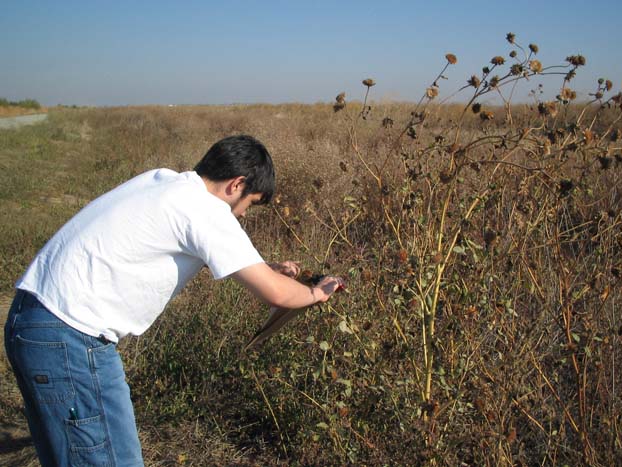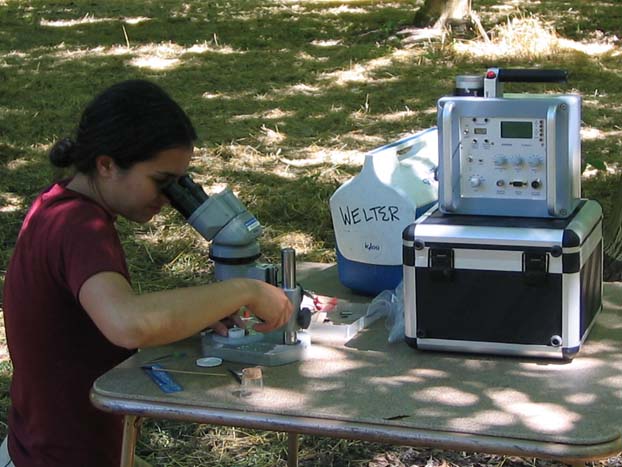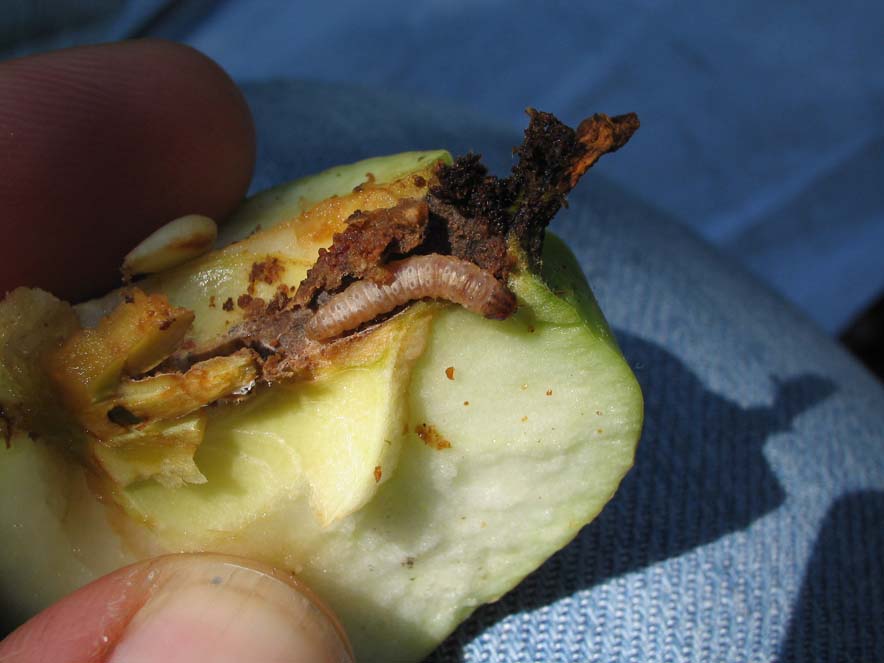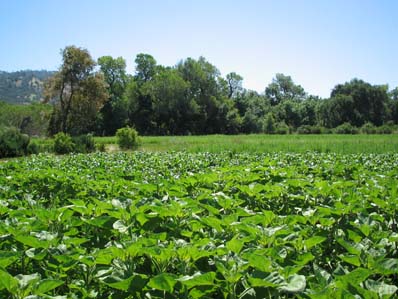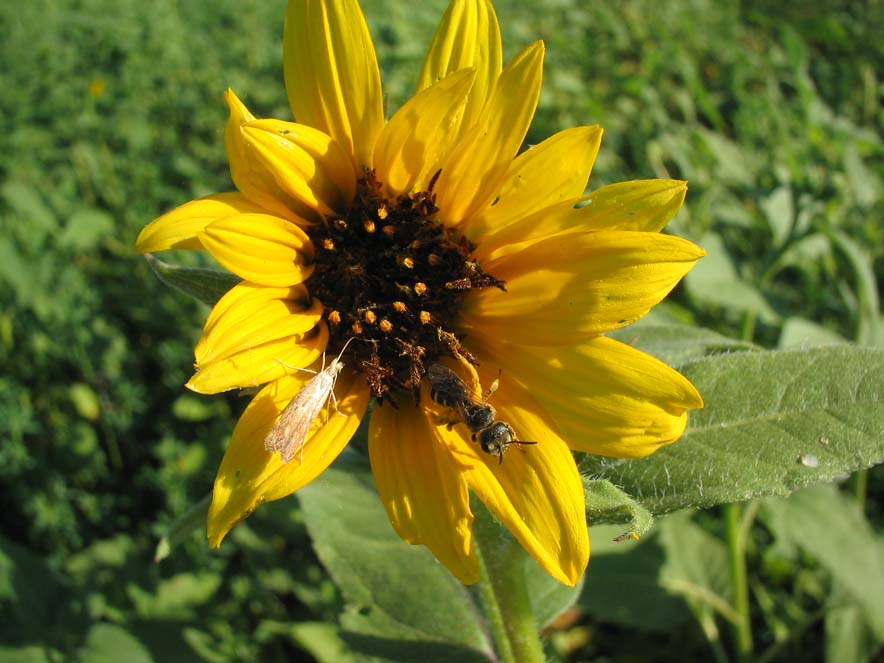| lab research | |||
|
Research in our lab focuses on fundamental questions of plant-insect interactions in both native and managed ecosystems as well as their implications for understanding and designing alternative agricultural systems. Studies have ranged in scale from the behavior of individual moths to population regulation by natural enemies of insects to estimations of gene flow at a landscape level. Projects in both wild and agricultural ecosystems have addressed basic ecological questions of host range expansion, the roles of competition or predation on herbivore population levels, and system trait effects on herbivory. Current projects use wild and agricultural sunflower as model systems, whereas previous research has included strawberries, maize, or tomatoes. More applied aspects of our research have focused on the development bio-intensive programs as alternatives to insecticides. One program interferes with mate location through the artificial deployment of various chemicals including insect sex pheromones or plant volatiles. Studies ranging from electrophysiological responses of antennae to large areawide pheromone mating disruption programs have helped to produce a viable alternative to insecticides for codling moth, the key pest of apples and pears. Other research has focused on more applied aspects of biological control in strawberries, apples, or pears including the role of plant structures as refugia from natural enemies or detection of prey DNA in the guts of generalist predators.
selected publications (1999-present)
Gratton, C. and Welter, S. C. 1999. Does "enemy-free space" exist? Experimental host shifts of an herbivorous fly. Ecology 80 N3:773-785. Walker, K. R. and Welter, S. C. 1999. Effects of lure dose on efficacy of pheromone traps for monitoring Argyrotaenia citrana (Lepidoptera : Tortricidae) in California apple orchards. J. Econ. Entomol. 92: 574-582. Udayagiri, S., Norton, A. P., and Welter, S. C. 2000. Integrating pesticide effects with inundative biological control: interpretation of pesticide toxicity curves for Anaphes iole in strawberries. Entomologia Experimentalis et Applicata 95: 87-95. Dunley, J. E. and S. C. Welter. 2000. Correlated insecticide cross-resistance in azinphosmethyl resistant codling moth (Lepidoptera: Tortricidae). J. Econ. Entomol. 93: 955-962. Udayagiri, S. and Welter, S. C. 2000. Escape of Lygus hesperus (Heteroptera: Miridae) eggs from parasitism by Anaphes iole (Hymenoptera: Mymaridae) in strawberries: Plant structure effects. Biological Control 17 (3): 234-242. Welter, S. C. 2001.). Contrasting plant responses to herbivory in wild and domesticated habitats. pp. 161-184. In: Biotic stress and yield loss. R. K. D. Peterson and L. G. Higley (eds), CRC Press. Boca Raton. Udayagiri, S.; Welter, S. C.; Norton, A. P. 2000. Biological control of Lygus hesperus with inundative releases of Anaphes iole in a high cash value crop. In: Southwestern Entomol. (23): 27-38. Gratton, C. and Welter, S.C. 2001. Parasitism of natural populations of Liriomyza helianthi Spencer and Calycomyza platyptera (Thomson) (Diptera: Agromyzidae). Biological Control 22: 81-97. Brunner, J.F., S. Welter, C. Calkins, R. Hilton, E. Beers, J. Dunley, T. Unruh, A. Knight, R. Van Steenwyk, P. Van Buskirk. 2001. Mating disruption of codling moth: a perspective from the Western United States. IOBC WPRS Bulletin 25(1): 207-215. Walker, K. R. and S. C. Welter. 2001. Potential for outbreaks of leafrollers (Lepidoptera: Tortricidae) in California apple orchards using mating disruption for codling moth suppression. J. Econ. Entomol. 94(2): 373-380. Chen, Y.H. and S. C. Welter. 2002. Abundance of a native moth Homoeosoma electellum (Lepidoptera: Pyralidae) and activity of indigenous parasitoids in native and agricultural sunflower habitats. Environ. Entomol. 31(4): 626-636. Welter, S. C., R. A. Van Steenwyk, and F. Cave. 2002. Development of alternative pheromone dispensing technologies for management of codling moth, pp. 321-359. In: 2002 California Walnut Marketing Board Research Reports. Agusti, N., T. R. Unruh, and S. C. Welter. 2003. Detecting Cacopsylla pyricola (Hemiptera: Psyllidae) in predator guts using COI mitochondrial markers. Bull. Entomol. Res. 93: 179-185. Chen, Y.H. and S. C. Welter. 2003. Confused by domestication: incongruent behavioral responses of the sunflower moth, Homoesoma electellum (Lepidoptera: Pyralidae) and its parasitoid, Dolichogenidea homoeosomae (Hymenoptera: Braconidae), towards wild and domesticated sunflowers. Biol. Control. 28: 180-190. Welter, S. C., F Cave and R. Van Steenwyk. 2003. Development of alternative dispensing technologies for management of codling moth, pp. 321-359. In: 2003 California Walnut Marketing Board Research Reports. Welter, S. C. 2003. Codling Moth. Pp 198-199. In Encyclopedia of Insects. V. Resh and R. Carde (eds). Academic Press. San Diego. Walker, K. R. and S. C. Welter. 2004. Biological control potential of Apanteles aristoteliae (Hymenoptera: Braconidae) on populations of Argyrotaenia citrana (Lepidoptera: Tortricidae) in California apple orchards. Environ. Entomol. 33(5): 1327-1334. Welter, S. C., C. Pickel, J. Millar, F. Cave, R. A. Van Steenwyk, and J.E. Dunley. 2005. Pheromone mating disruption offers selective management options for key pests. California Agriculture 59(1): 16-22. Chen, Y. H. and S. C. Welter. (in press) Crop domestication disrupts a native tritrophic interaction associated with the sunflower, Helianthus annuus (Asterales: Asteraceae). Ecol. Entomol
|
|
||

